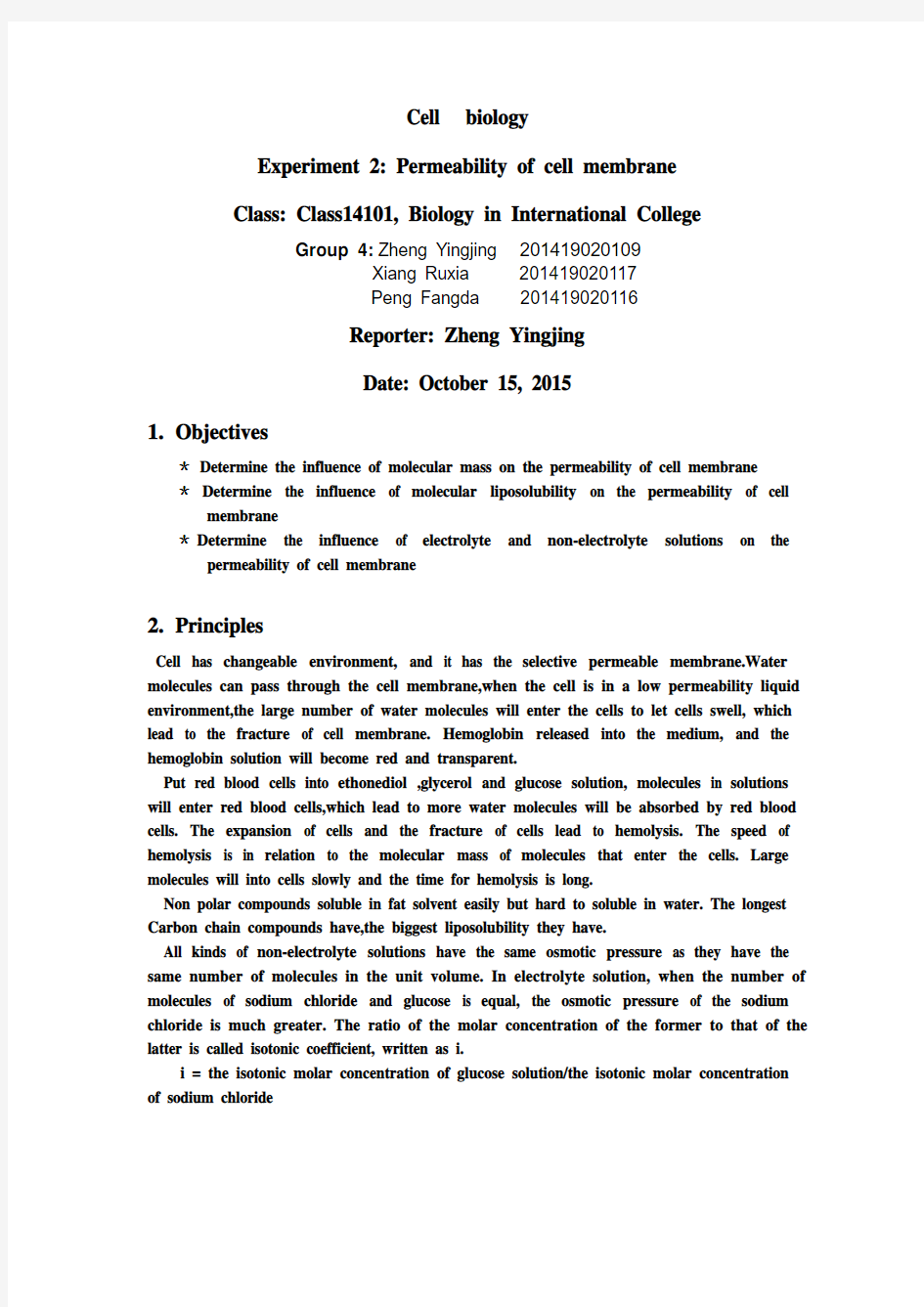Cell biology experiment 2


Cell biology
Experiment 2: Permeability of cell membrane
Class: Class14101, Biology in International College
Group 4: Zheng Yingjing 201419020109
Xiang Ruxia 201419020117
Peng Fangda 201419020116
Reporter: Zheng Yingjing
Date: October 15, 2015
1.Objectives
*Determine the influence of molecular mass on the permeability of cell membrane *Determine the influence of molecular liposolubility on the permeability of cell membrane
*Determine the influence of electrolyte and non-electrolyte solutions on the permeability of cell membrane
2.Principles
Cell has changeable environment, and it has the selective permeable membrane.Water molecules can pass through the cell membrane,when the cell is in a low permeability liquid environment,the large number of water molecules will enter the cells to let cells swell, which lead to the fracture of cell membrane. Hemoglobin released into the medium, and the hemoglobin solution will become red and transparent.
Put red blood cells into ethonediol ,glycerol and glucose solution, molecules in solutions will enter red blood cells,which lead to more water molecules will be absorbed by red blood cells. The expansion of cells and the fracture of cells lead to hemolysis. The speed of hemolysis is in relation to the molecular mass of molecules that enter the cells. Large molecules will into cells slowly and the time for hemolysis is long.
Non polar compounds soluble in fat solvent easily but hard to soluble in water. The longest Carbon chain compounds have,the biggest liposolubility they have.
All kinds of non-electrolyte solutions have the same osmotic pressure as they have the same number of molecules in the unit volume. In electrolyte solution, when the number of molecules of sodium chloride and glucose is equal, the osmotic pressure of the sodium chloride is much greater. The ratio of the molar concentration of the former to that of the latter is called isotonic coefficient, written as i.
i = the isotonic molar concentration of glucose solution/the isotonic molar concentration of sodium chloride
3.Materials
3.1Equipments and tools: small beakers, test tubes, test-tube racks, calibrated suction pipes,
syringes, chronograph.
3.2Materials: chicken blood with adequate anticoagulant agent-heparin.
3.3Reagant (aqueous solution): 1mol/L ethonediol , 1mol/L glycerol , 1mol/L glucose,
3mol/L methanol, 3mol/L ethanol, 3mol/L propanol, M/8 glucose, glucose with different concentration gradients: M/8, M/9, M/10, M/12, M/14, NaCl with different concentration gradients: M/12, M/13, M/14, M/16, M/18, and physiological saline solution (0.85% NaCl).
4.Experimental length
3h
5.Experimental steps
5.1 Determine the influence of molecular mass on the permeability of cell membrane
(1) Number 2 test tubes from 1 to 2. Add in 2ml distilled water, 0.85% NaCl into each test tube respectively with calibrated suction pipes.
(2) Add two droplets of blood samples into each test tube with syringe, shake gently.
(3) Number 3 test tubes from 1 to 3. Add in 2ml 1mol/L ethonediol , 1mol/L glycerol , 1mol/L glucose respectively with calibrated suction pipes.
(4) Add in 2 droplets of blood into each test tube with syringe, mix gently. Start timing using
a chronograph.
(5)Write down the time needed for hemolysis to happen. Wait no more than 10 min.
5.2 Determine the influence of molecular liposolubility on the permeability of cell membrane (1) Number 3 test tubes from 1 to 3. Add in 2ml 3mol/L methanol, 3mol/L ethanol, 3mol/L propanol respectively with calibrated suction pipes.
(2) Add in 2 droplets of blood into each test tube, mix gently. Start timing.
(3) Write down the time needed for hemolysis.
5.3 Determine the influence of electrolyte and non-electrolyte solutions on the permeability of cell membrane
(1) Number 10 test tubes from 1 to 10. Label with the name and concentration of the solutes
on them.
(2) Add in 2ml corresponding solutions into the test tubes with calibrated suction pipes.
(3) Add in 2 droplets of blood into each test tube with syringes. Vibrate gently. Wait for 15min.
(4) Fill the following form with yes or no. The concentration of the solution that starts to not cause hemolysis is considered as the approximate isotonic molar concentration of glucose solution relative to erythrocytes, same for NaCl.
6.Results and discussion
In our conclusion, the time for hemolysis in ethonediol solution is shortest,the time for hemolysis in glucose solution is longest.Because the molecular mass of ethonediol is smallest and the molecular mass of glucose is biggest, the molecular mass of glycerol is the second one. The speed of hemolysis is in relation to the molecular mass of molecules that enter the cells.
hemolysis in methanol solution is longest. Because the carbon chain of propanol is longest,the carbon chain of methanol in shortest ,the carbon chain of ethanol is the second one. Non polar compounds soluble in fat solvent easily but hard to soluble in water. The longest Carbon chain compounds have,the biggest liposolubility they have.
6.3.Determine the influence of electrolyte and non-electrolyte solutions on the permeability
i = M/9 / M/13 = 1.44
When Glucose solution and NaCl solution are isotonic,the isotonic concentration of the non-electrolyte solution and the isotonic concentration of an electrolyte solution have big
differences. Because all kinds of non-electrolyte solutions have the same osmotic pressure as they have the same number of molecules in the unit volume. In electrolyte solution, when the number of molecules of sodium chloride and glucose is equal, the osmotic pressure of the sodium chloride is much greater.
7.References
7.1.https://www.sodocs.net/doc/ea684118.html,/
7.2“Essential Cell biology”, Bruce Alberts, Dennis Bray, Karen Hopkin etc. Page 383-340.
The fourth edition. Garland Science
7.3“Cell biology experiment”, Ling Li, Xuefeng Li etc. Human Science and Technology
Press in Changsha.
7.4“Cell biology experiment”, Hanming Yang etc. Higher Education Press in Beijing.
7.5“Cell biology experiment tutorial”, Danwei Ma etc. Science Press in Beijing.
7.6“Cell biology experiment tutorial”, Jinfa Wang, Yanming He etc. The second edition.
Science Press in Beijing.
